

7 Types Of Trailer Hitches: How To Pick The Best Hitch For Your Vehicle
When it comes to towing trailers, there is no one-size-fits-all solution. Every vehicle is different, and therefore requires a different type of hitch in order to tow safely and efficiently. In this guide, we will discuss the different types of trailer hitches available and how to pick the best hitch for your vehicle.
Types Of Trailer Hitches
There are so many different applications and uses for towing and so many different vehicle and vehicle types out there that the types of hitches available has grown to meet demand over the years.
There are 7 common types of trailer hitches we’ll be covering in todays guide:
Rear Receiver Hitch (Class 1-5)
Bumper hitch, weight distribution hitch, 5th wheel hitch, gooseneck hitch, pintle hitch, front mount hitch.
We’ll go through the pros and cons of each hitch type below, as well as what each is best used for.
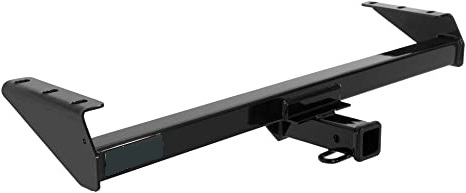
Rear receiver hitches are the most common type of hitch available and can be found on almost any vehicle.
They are classified by their weight capacity, with Class I (Class 1) being the lightest duty and Class V (Class 5) being the heaviest duty.
Receiver hitch sizes increase with the Class number.
Rear receiver hitches are very versatile and can be used for a variety of towing applications, including bike racks, cargo carriers, and trailer lights.
They are also relatively easy to install, making them a great option for those who are not mechanically inclined.
A receiver hitch features a square tube on the end that accepts different towing accessories, such as bike racks or trailer ball mounts.
Rear receiver hitches are great for use with nearly any type of towable ranging from a hitch cargo basket, jet ski trailer, pop-up campers, boat and utility trailers, all the way to full-size travel trailers.
We’ve put together a guide on parts of a trailer hitch for receiver hitches since they’re so common, so check that out if you have or are considering a rear receiver hitch.
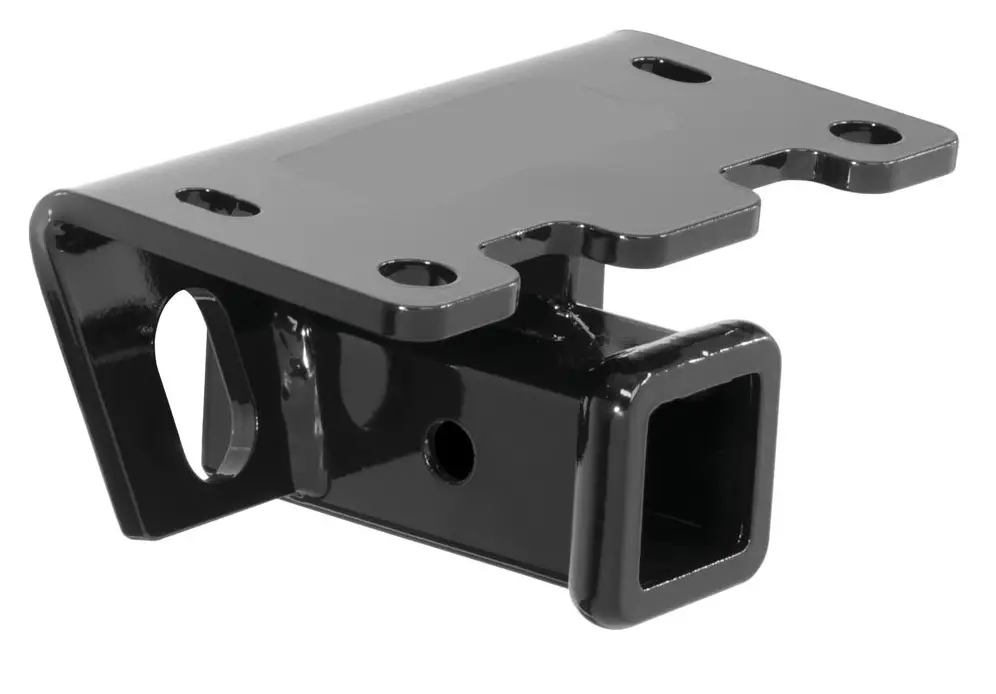
A bumper hitch is a type of hitch that mounts to the rear bumper of a vehicle.
These hitches are also quite common because they’re easy to install and are attached directly to the bumper of almost any vehicle.
This provides a square tube like a rear receiver hitch does for use with towing ball mounts or other towing accessories.
The receiver insert sizes range from 1-1/4″ to 3″ and can provide between 2,000 to 21,000 lbs of max towing capacity.
The key limitation here is that this hitch can only tow as much weight as your bumper can.
Because of this, bumper hitches are typically used for lighter loads, such as bike racks, small trailers, or pop-up campers.
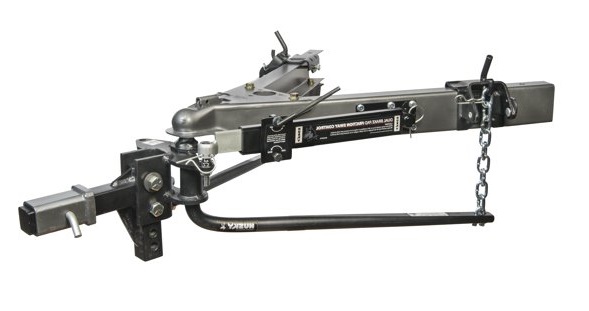
A weight distribution hitch is a type of trailer hitch that is used to distribute the tongue weight of a trailer evenly across the axle of a vehicle.
Another name for this type of hitch is a sway control hitch.
Weight distribution hitches utilize long rods called “spring rods” which provide leverage against the connection point to reduce the downward tongue weight at the connection point.
This is important because it helps to prevent sag and increases stability while towing.
Weight distribution hitches are typically used for heavier trailers, such as travel trailers or fifth-wheel trailers.
These hitches are more complex than bumper hitches or rear receiver hitches, and therefore can be more difficult to install.
However, once installed properly, a weight distribution hitch provides a much smoother ride while towing and can be a great option for those who frequently tow heavy loads.
It’s important to note that weight distribution hitches typically aren’t standalone, and are usually mounted to a rear receiver hitch.
They’re still classified as a type of hitch anyway, but are also referred to as hitch stabilizers .

A fifth wheel hitch is a type of hitch that mounts in the bed of a pickup truck and is used to tow a fifth wheel trailer.
Fifth wheel trailers are typically larger and heavier than travel trailers, and as such require a more heavy-duty hitch for towing.
Fifth wheel hitches mount directly to the frame of a pickup truck near the rear axle and provide a strong connection point for towing.
The connection is a little like the opposite of a trailer ball, where the 5th wheel hitch has a U-shape mechanism with locking jaws that closes around a kingpin on the trailer.
These hitches can provide up to 30,000 lbs of max towing capacity, making them ideal for use with large fifth wheel trailers.
Installing a fifth wheel hitch can be more difficult than other types of hitches because it requires drilling into the bed of the truck.
However, once installed properly, a fifth wheel hitch provides a very stable connection for towing even the heaviest of loads.
It’s important to note that 5th wheel hitches are only available for pickup trucks.
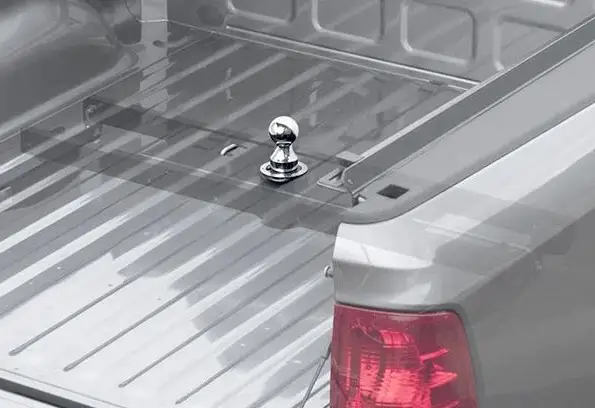
A gooseneck hitch is a type of trailer hitch that mounts to the bed of a pickup truck and is used to tow a gooseneck trailer.
Gooseneck trailers are similar to fifth wheel trailers in that they are typically larger and heavier than travel trailers.
However, unlike fifth wheel hitches, gooseneck hitches mount directly to the frame of the truck near the cab.
This provides a shorter distance between the connection point and the trailer axle, which helps to improve stability while towing.
Gooseneck hitches look like a trailer ball protruding from the bed of the truck, which is where the gooseneck trailer coupler sits on.
Gooseneck hitches can provide up to 30,000 lbs of max towing capacity, making them ideal for use with large gooseneck trailers.
Installing a gooseneck hitch can be more difficult than other types of hitches because it also requires drilling into the bed of the truck.
A gooseneck hitch provides a very stable connection for towing even the heaviest of loads.
Just like 5th wheel hitches, gooseneck hitches are only available for pickup trucks.
You’ll see gooseneck hitches most often used with car haulers, large flatbeds, livestock trailers, or other industrial and commercial trailers.
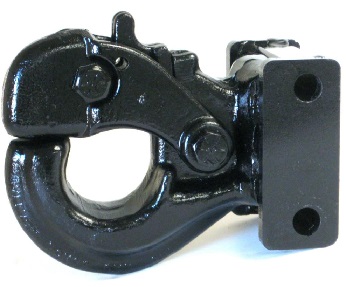
A pintle hitch is a type of hitch that uses a pin and collar system for towing.
Pintle hitches are typically used for heavy-duty towing applications, such as with military trailers or construction equipment.
The pintle hitch consists of a large metal pin (the “pintle”) that inserts into a receiver on the vehicle, and a ring (called the lunette), which that secures the pin in place.
Pintle hitches provide up to 60,000 lbs of max towing capacity and are commonly found on dump trucks, construction and industrial equipment, agricultural applications, and even military vehicles.
They allow for a wider range of motion than a tow ball, which makes them better for off-road use like construction or farming.
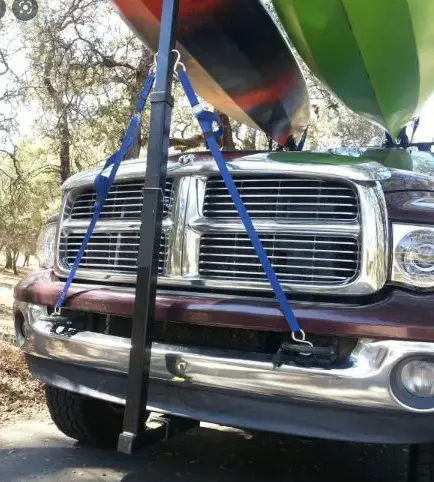
A front mount hitch is similar to a rear receiver hitch, except it is bolted to the frame in the front of your vehicle.
Beyond that, the look is pretty similar, with a receiver tube that accepts different accessories.
Common uses for front mount hitches area snow plows, winches, spare tire mounts, cargo baskets, and more.
Front mounts are usually rated for less weight than rear receiver hitches.
Different Types Of Trailer Hitches: Wrapping Things Up
You’ll see trailer hitches on every type of vehicle.
There are many different types of hitches available on the market today.
Each type of hitch is designed for a specific purpose and has its own set of advantages and disadvantages.
When choosing a hitch, it’s important to consider your vehicle’s towing capacity, what you’ll be using it for, and how much weight you’ll be towing.
With so many options available, there’s sure to be a hitch that’s perfect for your needs.
Leave a Comment Cancel reply
Save my name, email, and website in this browser for the next time I comment.
Terms and Conditions - Privacy Policy
JavaScript seems to be disabled in your browser. For the best experience on our site, be sure to turn on Javascript in your browser.
- My Purchase Orders
- Compare Products

- Understanding Towing
- Types of Trailer Hitches & Hitch Classes - Chapter 3
Types of Trailer Hitches & Hitch Classes

What are the different types of trailer hitches?
There are many different types of hitches used for towing a trailer. Receiver hitches are perhaps the most common, divided into 5 classes . Some of the other hitch types include 5th wheel hitches and gooseneck hitches.
Each type of trailer hitch has a unique purpose and coupling style, as well as its own set of capacities and sizes.
Types of trailer hitches

Receiver Hitch
Capacity: Up to 20,000 lbs.
Provides a tube for accessories
Available for most vehicles
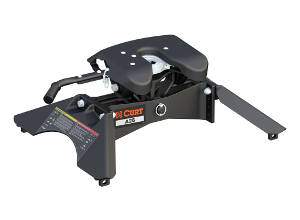
5th Wheel Hitch
Capacity: Up to 30,000 lbs.
Couples to a 5th wheel kingpin
Pickup trucks only
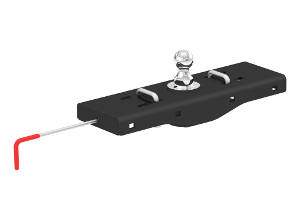
Gooseneck Hitch
Capacity: Up to 38,000 lbs.
Couples to a gooseneck trailer

Weight Distribution Hitch
Capacity: Up to 15,000 lbs.
Helps level vehicle and trailer
Requires hitch receiver

Pintle Hitch
Capacity: Up to 60,000 lbs.
Couples to a lunette ring
Available for heavy-duty vehicles
Learn more about different types of towing here
5 Trailer Hitch Classes
Receiver hitches are divided into 5 classes, depending on their towing capacity and receiver tube size. The higher the class number, the higher the capacity and the larger the receiver tube is.
While it is helpful to distinguish between the various tow hitch classes, it is important to note that most receiver hitches are made vehicle-specific. In other words, not all 5 classes are available for each vehicle.
Hitch Class Comparison Chart

Trailer Hitch Receiver Sizes
There are four standard trailer hitch sizes: 1-1/4", 2", 2-1/2" and 3". The hitch size refers to the inside dimensions of the hitch receiver.
Using a standard hitch size approach allows for more versatile towing options. It enables you to attach a variety of towing accessories to your vehicle, without the need for an adapter or modifications.
Trailer Hitch Class Ratings
Across the five hitch classes, weight ratings vary greatly, from 2,000 lbs. up to 20,000 lbs. Each individual hitch comes with its own specific weight ratings which may or may not reach the maximum range of the designated hitch class.
Remember, your towing capacity is always limited to the lowest-rated towing component, whether the hitch, an accessory, the vehicle, your trailer or any other component of the towing system.

Hitch Class Details
Class 1 hitch.
Receiver Size: 1-1/4" x 1-1/4" receiver Weight Rating: Up to 2,000 lbs. GTW

Class 1 Hitches Explained
Class 1 trailer hitches are generally designed for passenger cars and small crossovers. They are equipped with a 1-1/4" x 1-1/4" receiver tube opening or sometimes a fixed tongue to directly mount a trailer ball instead of a ball mount.
Most class 1 hitches are rated to tow trailers up to 2,000 lbs. However, it is important to remember that not all hitches are rated at the same capacity and that no hitch ever increases the maximum weight a vehicle can tow.
Class 1 vs Class 2 Hitch
Class 1 hitches and class 2 hitches both have a 1-1/4" x 1-1/4" receiver tube and are designed for towing light-duty trailers. They also mount onto similar vehicle types, including cars, vans and crossovers.
Class 1 hitches are different from class 2 hitches in that, generally, class 1 hitches have a lower weight rating. While class 1 maxes out around 2,000 lbs., class 2 is typically rated up to 3,500 lbs.

Class 2 Hitch
Receiver Size: 1-1/4" x 1-1/4" receiver Weight Rating: Up to 3,500 lbs. GTW

Class 2 Hitches Explained
Class 2 trailer hitches have a 1-1/4" x 1-1/4" receiver tube opening and are used for lightweight towing applications. Most class 2 hitches are able to tow up to 3,500 lbs. gross trailer weight.
Class 2 hitches are typically found on full-size sedans, minivans and crossovers but can also be found on small SUVs and even pickup trucks.
Class 2 vs Class 3 Hitch
Class 2 hitches are quite different from class 3 hitches. Class 2 hitches have a 1-1/4" receiver and generally only go up to 3,500 lbs. GTW. On the other hand, class 3 hitches have a 2" receiver and can range up to 8,000 lbs. gross trailer weight.
Additionally, some class 3 hitches are able to be used with a weight distribution hitch for a towing capacity as high as 12,000 lbs.

Class 3 Hitch
Receiver Size: 2" x 2" receiver Weight Rating: Up to 8,000 lbs. GTW

Class 3 Hitches Explained
The class 3 trailer hitch is the most common receiver hitch class installed on full-size pickup trucks and SUVs. If your truck is equipped with a towing prep package, it probably has a class 3 hitch.
CURT class 3 hitches are equipped with a 2" x 2" receiver tube opening and typically have a weight carrying capacity up to 8,000 lbs. gross trailer weight. Some class 3 hitches can also be used in combination with a weight distribution hitch.
Class 3 hitches are extremely versatile, able to tow a variety of trailer types and load size. Not sure how much your trailer weighs? Learn more about trailer weight here .
Class 3 vs Class 4 Hitch
Class 3 hitches and class 4 hitches both have 2" x 2" receiver tubes. Class 3 is different in that class 3 hitch weight ratings are consistently lower than class 4 hitches. This makes class 3 hitches much more versatile in terms of vehicle applications. They are found on everything from crossovers to pickup trucks.
Many class 3 and class 4 hitches are also compatible with a weight distribution hitch though not all. This provides increased weight capacity and control.

Class 4 Hitch
Receiver Size: 2" x 2" receiver Weight Rating: Up to 10,000 lbs. GTW

Class 4 Hitches Explained
Class 4 trailer hitches are commonly mounted on full-size pickup trucks and SUVs. They feature a 2" x 2" receiver tube opening and generally have a weight carrying capacity up to 10,000 lbs. gross trailer weight.
Most class 4 hitches can also utilize a weight distribution hitch for ratings as high as 12,000 lbs.
Class 4 vs Class 5 Hitch
Class 4 hitches are fairly different compared to class 5 hitches. Class 4 hitches are generally only rated up to 10,000 lbs. and are restricted to a 2" receiver. One of the only similarities between the two is that some class 5 hitches also have a 2" receiver.
Class 5 hitches, however, are also available with a 2-1/2" receiver and are rated as high as 20,000 lbs., accommodating some of the heaviest tow loads.

Class 5 Hitch
Receiver Size: 2" or 2-1/2" receiver Weight Rating: Up to 20,000 lbs. GTW

Class 5 Hitches Explained
Class 5 trailer hitches have the highest weight ratings of the receiver hitch classes, offering as much as 20,000 lbs. GTW. They are typically used on full-size pickups and commercial trucks.
CURT offers two types of class 5 hitches. Xtra Duty (XD) class 5 hitches have a 2" receiver and are rated for up to 17,000 lbs. Commercial Duty (CD) class 5 hitches have a 2-1/2" receiver and are rated for as much as 20,000 lbs.
Always choose a trailer hitch that matches your vehicle's towing capacity. You may not need the full capacity now, but if ever you want to pull a larger trailer, it pays to have a hitch that is already equipped to handle the weight.

Different Types of Hitch Receivers
There are a few different receiver hitches that may or may not fit within the five classes. Most of them are widely used on vehicles today, and each comes with a standard receive tube size.

Custom Hitch
This type of trailer hitch is designed for a very specific vehicle application, providing the best fit, easiest install and optimal weight capacity.
Shop custom hitches

Rear Mount Hitch
This type of receiver hitch attaches to the rear of a tow vehicle, providing a standard receiver tube for hooking up and pulling a trailer.
Shop rear hitches

Multi-Fit Hitch
This type of trailer hitch is designed to fit as many vehicles as possible, while providing a standard hitch receiver and on-par weight capacity.
Shop multi-fit hitches

Bumper Hitch
This type of receiver hitch attaches to a vehicle's bumper and provides a standard receiver tube. Its weight capacity is limited to the bumper.
Shop bumper hitches

This type of receiver hitch is specifically designed to mount at the rear of an RV or motorhome to tow a trailer or dinghy tow a vehicle.
Shop RV hitches

Heavy-Duty Tow Hitch Types
There are a number of different types of tow hitches that do not fall within the receiver hitch classification. These hitches are designed for heavier towing applications and commonly used for towing travel trailers, livestock trailers, flatbed equipment trailers and more.

A gooseneck hitch is a heavy-duty truck bed hitch that provides a ball to couple to a gooseneck trailer. Gooseneck hitches are commonly used on farms.
Shop gooseneck hitches
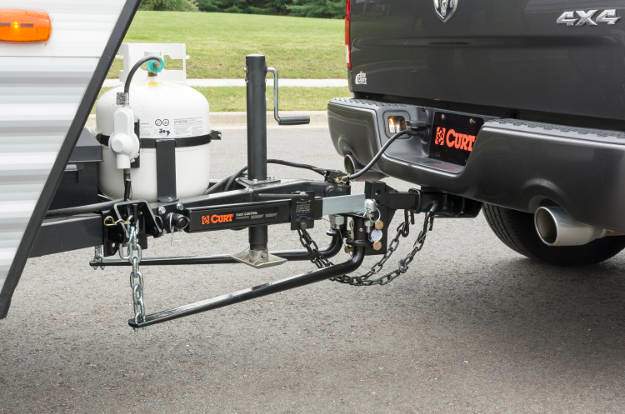
A weight distribution hitch is a receiver hitch attachment. It is designed to distribute the tongue weight of a trailer across the vehicle and trailer for increased control.
Shop weight distribution hitches
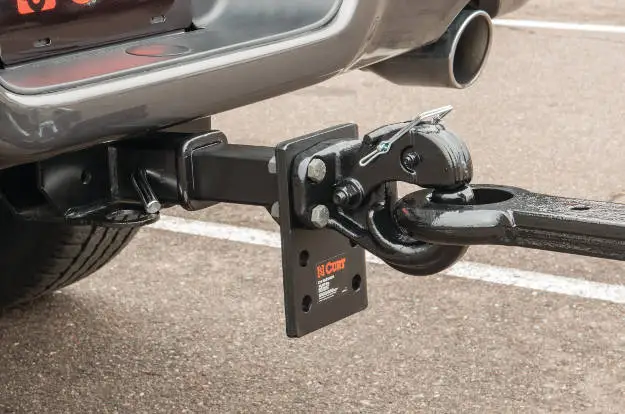
A pintle hitch is a simple but strong coupling mechanism, consisting of a hook and a ring. Pintle hitches are commonly used in agriculture and industrial settings.
Shop pintle hitches
Not sure where to start? Look up your vehicle to find a trailer hitch !
How to tell what hitch class I have ?
Class 1: If you drive a car or crossover, you likely have a Class 1 hitch. Class 1 hitches have 1-1/4-inch receiver sizes, and have a GTW capacity of up to 2,000 lbs. and a TW capacity of up to 200 lbs.
Class 2: If you drive a minivan or have a car or crossover that is on the bigger or more heavy-duty side, you likely have a Class 2 hitch. Class 2 hitches have 1-1/4-inch receiver sizes, and have a GTW capacity of up to 3,500 lbs. and a TW capacity of up to 350 lbs.
Class 3: If you drive a crossover, van, SUV or truck, you likely have a Class 3 hitch. Class 3 hitches have 2-inch receiver sizes, and have a GTW capacity of up to 8,000 lbs. and a TW capacity up to 800 lbs. They also have a WD capacity of up to 12,000 lbs. and WDTW capacity of up to 1,200 lbs.
Class 4: If you drive a larger truck or SUV, you likely have a Class 4 hitch. Class 4 hitches have 2-inch receiver sizes, and have a GTW capacity of up to 10,000 lbs. and a TW capacity up to 1,000 lbs. They also have a WD capacity of up to 12,000 lbs. and WDTW capacity of up to 1,200 lbs.
Class 5 – Xtra Duty: If you drive a heavy-duty or super-duty truck or SUV, you have a Class 5 – Xtra Duty hitch. Class 5 – Xtra Duty hitches have 2-inch receiver sizes, and have GTW capacities of 16,000 to 17,000 lbs. and TW capacities of 2,400 to 2,550 lbs. They also have a WD capacity of 17,000 lbs. and WDTW capacities of 2,400 to 2,550 lbs.
Class 6 – Commercial Duty: If you have a Dually or chassis cab truck, you have a Class 5 – Commercial Duty hitch. Class 5 – Commercial Duty hitches have 2-1/2-inch receiver sizes, and have GTW capacities of 18,000 to 20,000 lbs. and a TW capacity of 2,700 lbs. They also have WD capacities of 18,000 to 20,000 lbs. and a WDTW capacity of 2,700 lbs.
Towing 101 Table of Contents
Looking for more.
Discover more great tips and how-tos on the Lippert blog -- your destination for all things RVing, towing, boating and beyond!
Essential Guide to the Different Types of Trailer Hitches
If you’re new to the towing world and need a trailer hitch, you may write it off as an easy decision requiring very little thought and consideration . However, there are half a dozen trailer hitches , each serving a different purpose. Therefore, it’s important to know how each type of trailer hitch works so that you can choose the right one for your needs.
Exploring Trailer Hitch Varieties
All in all, there are seven different types of trailer hitches, including the following:
- Rear Receiver / Mount hitch
- Front Mount Hitch
- Gooseneck hitch
- Fifth wheel hitch
- Pintle hitch
- Weight distribution hitch
A rear mount hitch is the most common type of hitch you’ll see on the open highway. It is commonly used to tow anything from a small trailer to a large RV and can be installed on any type of vehicle. However, it has limitations on where it can be used, explaining why so many other types of hitches are available.
Rear Receiver Bumper Hitches
Common hitch type with a square receiver tube, mounted directly to the vehicle frame, and weight ratings based on a 5-class scale. As we said before, the bumper hitch is the most common hitch available, given that it can be used on any type of vehicle.
The five weight classes for a ball mount receiver hitch are as follows:
- Class 1 – Can handle up to 2,000 pounds
- Class 2 – Can handle up to 3,500 pounds
- Class 3 – Can handle up to 8,000 pounds
- Class 4 – Can handle up to 10,000 pounds
- Class 5 – Can handle up to 20,000 pounds
It’s important to have the right class of bumper hitch for your vehicle. For instance, if you have a Subaru Outback with a towing capacity of 3,000 pounds, you’ll want a Class 1 or 2 hitch. If you have a truck, minivan , or SUV with more towing power, you’ll want a Class 3 or 4 rear receiver hitch.
There are many different companies that make rear-receiver trailer hitches, but Curt is one of the best. You can use this type of hitch to tow a travel trailer with your truck, a small boat with your SUV, or even a tiny moving trailer with your car.
Image courtesy of Etrailer
How Neighbor is changing RV storage
Transparent monthly savings.
Renters save 30-50% on RV storage, on average. No rate hikes.

Keep your RV nearby
25,000 locations means that your RV is always close by.
Storage made simple
Don't settle for stone age tech and long contracts. Neighbor makes it easy.
Front Mount Hitches
Although they aren’t quite as common or heavy-duty as rear-receiver hitches, front-mount trailer hitches are another good option. Front-mount hitches are a versatile option that bolts to the vehicle’s front frame, which is ideal in applications like bike racks, cargo carriers, or snow plows.
While you can’t tow a trailer or RV with a front-mount trailer hitch , they’re perfect for bike carriers and other types of cargo carriers. We often see them on trucks and SUVs that are towing a boat or travel trailer that also need a carrier for extra belongings.
As with a ball mount hitch, many great front-mount hitch options exist, including Curt, Reese, and Draw-Tite . They are basically like bumper hitches that mount to the front instead of the back and even feature the same square receiver tube. Most front-mount hitches can hold vertical loads of between 500 and 2,000 pounds and can push or pull up to 8,000 pounds.
5th-Wheel Hitches
A fifth-wheel hitch is a heavy-duty hitch for pickup trucks that tow large campers, travel trailers, and car haulers.
Fifth-wheel hitches sit directly above the rear axle of the towing vehicle, and it attaches to whatever you’re towing via a coupling device and kingpin, rather than a ball and hitch.
A 5th-wheel hitch has significantly more towing capabilities than a ball-mount rear hitch and can handle up to 30,000 pounds. It’s typically bolted to the bed of a pickup truck, then the kingpin of your trailer slides into the receiver on the hitch, which then locks it firmly in place.
Many reputable manufacturers of fifth-wheel tow hitches exist, but Reese stands out as one of the best.
Image courtesy of Etrailer
Gooseneck Hitches
Gooseneck hitches are designed for heavy-duty towing of up to 30,000 lbs, are suitable for pickup trucks, and are often used for commercial and industrial trailers.
These types of hitches get their name because they’re only compatible with gooseneck trailers.
Gooseneck hitches are like a combination of a 5th-wheel hitch and a bumper hitch. The hitch sits in the bed of a pickup truck or semi but consists of a round ball and coupler, similar to that of a bumper hitch, rather than the kingpin locking mechanism of a standard fifth wheel. B&W makes one of the top gooseneck trailer hitches on the market.
Image courtesy of Etrailer
Pintle Hitches
If you need one of the most heavy-duty hitches on the market, the pintle hitch, such as the Brophy , is the way to go. These hitches are often used as a hooking system for commercial trucks in the construction, military, and agricultural industries.
Generally speaking, a pintle hitch can tow anywhere from 10,000 to 60,000 lbs.
A pintle hitch attaches to the rear of your towing vehicle, but instead of a ball, there’s a hook. The hook then clasps to a pin on the front of whatever you’re towing and locks it into place. This pintle system allows for more movement and leeway than a traditional rear-mount hitch , which is why it’s commonly used on rough terrain.
Save up to $1,200/year on RV storage & parking
Weight distribution hitches: balancing the load.
Last but not least, you can also choose a weight distribution hitch (WDH.) As the name implies, weight distribution hitches are meant to distribute the weight of whatever you’re towing across the entire frame of the towing vehicle. It consists of a rear-mount receiver hitch, a ball and coupler, and weight distribution bars that attach from the front of the trailer to the hitch.
How a Weight Distribution Hitch Works
With a traditional rear-mount hitch, all of the weight of whatever you’re towing sits on the rear bumper of the towing vehicle. This creates a lot of wear and tear and increases the risk of the trailer swaying, causing an accident.
Because of how the weight distribution bars connect from the trailer to the hitch, it takes most of the weight off the rear bumper and distributes it over the front and rear axles. This eases the strain exerted on your tow vehicle and makes for a safer and more comfortable towing experience.
Additionally, because the trailer’s weight is now evenly distributed throughout the entire towing vehicle, weight distribution hitches often have a higher towing capacity than a typical rear hitch. I highly recommend a WDH, such as the Reese Pro System , to any beginner because of how much easier it is to tow RVs, boats, and heavy trailers with a weight distribution hitch.
Matching Trailer Hitch Types to Towing Applications
Now that you know the various trailer hitch types, let’s look at how to choose the type that’s right for you.
If you’re towing an RV, you can use three different types of hitches: a fifth-wheel hitch, a weight distribution hitch, or a standard receiver hitch. You’ll need a fifth-wheel hitch if you have a fifth-wheel camper, and a weight distribution hitch if you have a travel trailer weighing more than 5,000 pounds.
For travel trailers with a tongue weight of less than 250 pounds and gross trailer weight of less than 3,500 pounds, a standard rear-mount hitch is sufficient.
Livestock Trailers
Choosing the right hitch for your livestock trailer depends on your towing needs. While somewhat self-explanatory, you’ll need a gooseneck hitch if your livestock trailer has a gooseneck . If it’s a fifth-wheel, you will need a fifth-wheel hitch . If you have a light-duty livestock trailer with a front coupler , a rear-receiver trailer hitch will do.
Heavy-Duty Trucks
Heavy-duty trucks, such as semis or large flatbeds, will need either a gooseneck hitch or a pintle hitch , depending on the type of trailer you’re towing.
Final Thoughts
In addition to choosing the right type of hitch based on what you’re towing, there are also many different brands of hitches within each category. It’s important to match the towing capacity of the hitch you choose to the towing capacity of your tow vehicle. You should also consider weight capacity if you’re choosing a front or rear hitch system for a snow plow, cargo carrier, or bike rack.
Once you’re finished towing your RV, utility trailer, or flatbed, you’ll need a safe and secure place to store your load . Consider using Neighbor , a peer-to-peer storage marketplace, to find safe, affordable, and climate-controlled storage near you!

Related Posts
- RV Ownership
How to Tow an RV: Expert Tips and Techniques
Comparing 5th wheel vs. travel trailer: what’s the difference.
- Personal Cars
How to Increase Towing Capacity Effectively
Stabilize your ride: top sway bars for camper safety and control.
- Other Vehicles
How to Tie Down a Side By Side On a Trailer: 4 Steps
What is the best minivan for towing 5 top picks.

Justin earns $650/mo on Neighbor. Find out how you can too!
Stay in the loop ↓

Outdoor Blog
The 5 different types of trailer hitches (explained) .
With the growing popularity of tiny homes, RVs, and other alternative camping options, there’s a lot to explore in the world of trailers and trailer hitches. Whether you’re using a trailer hitch for the first time, trying to expand your options, or hauling with a new vehicle, understanding the difference between different types of trailer hitches can help you avoid all kinds of hassle.
You don’t want to finish setting up your new DIY camping trailer , just to find out you’ve got the wrong hitch to haul it. The first tip is to pay attention to the specifications in the owner’s manual for any trailer hitch. You can learn a lot from guides like this, but each vehicle and hitch is unique.
Pay special attention to the max towing capacity of your vehicle, trailer, hitch, and any other parts used. And remember, the max hauling capacity of any setup is determined by the weight limit of the lowest-rated component.
What to Consider When Buying Trailer Hitches
To start your search, consider a few basic questions about what you’re hauling, the vehicle you’ll be using, and any other features you might need. Trailer hitches are designed with specific vehicles in mind, so you’ll be somewhat limited in your options by the make, model, and year of the vehicle you’re hauling with.
That said, there are adapters available for many vehicles, so you can theoretically use just about any vehicle to haul a trailer. Still, you should be careful to consider the hauling capacity of your car, SUV, or truck. Most trailer hitches are a type of receiver hitch and these are available for most vehicles.
If you’re towing a standard travel trailer or wheel trailer, a receiver hitch should work fine. There are five different classes of receiver hitch that correspond to different towing capacities, up to about 20,000 lbs. After that, you’ll be looking at heavy-duty options, like a gooseneck hitch or fifth-wheel hitch.
After you’ve determined the proper hitch class and found a few options that are compatible with your vehicle, you can consider additional features you might want as well as the look of the hitch. It might sound silly, but you do want the trailer hitch you’re using to match the general style of your car!

Always remember to read the owner’s manual to fully understand each part of your trailer hitch.
Common Trailer Hitch Parts
Before we dive into the different types of hitches and what they’re used for, let’s go over some of the key parts you should know. The standard receiver hitch set-up, sometimes called a tow hitch, is made up of seven main parts. Other hitch systems, like pintle hitches, have different components, covered in part below.
First, the term “trailer hitch” itself refers specifically to the primary connector between your trailer and your vehicle. So, this includes the receiver tube (which will either be square or round) into which your trailer hitch attachment will be inserted. Commonly, this attachment will be a ball mount that consists of a shank and a trailer ball platform. The shank of the ball mount is secured in the receiver tube by a hitch pin or hitch lock.
Next, the trailer ball is attached to the platform and this provides the direct connection to the trailer. Trailer balls are available in a variety of sizes, so you want to make sure the one you’re using works with your trailer. It should match the trailer coupler, which is the metal latch on the trailer itself which attaches to your trailer ball.
Finally, your trailer hitch needs safety chains and a trailer wiring harness to be complete. These two components are independent of the main mechanical parts of the trailer hitch. A writing harness allows for electricity to flow from your vehicle to the trailer. Safety chains are intended to catch the trailer should something happen to your hitch. So they should be strong enough to stop the trailer if they need to.
Towing Power and Hitch Classes
So how do you determine the towing capacity of your vehicle and use weight ratings to figure out which class of receiver hitch you need? To start with, make sure you consider the towing capacity of your vehicle, the hitch, the trailer, and any accessories used. Your vehicle’s towing capacity will be noted in the owner’s manual, or you can look it up VIN or using the make, model, and year of your vehicle.
Once you know the weight capacity (or towing capacity) of your vehicle, you should determine the gross trailer weight or GTW of the trailer you’re towing. The gross trailer weight is the combined eight of your empty trailer, along with any luggage, passengers, materials, or anything else that will be carried in the trailer. Then, while ensuring that the GTW of your trailer and hitch set up don’t exceed your vehicle’s towing capacity, you can choose a hitch class.
Hitch Classes
Class I hitches are found on cars, crossovers, and SUVs. The smallest hitch available, Class I hitches can two up to 2,000 lbs and are rated for up to 200 lbs of tongue weight. The receiver tube is 1-1/4″ x 1-1/4″ and these hitches are good for light-duty towing.
Class II hitches are very similar to Class I and also feature a 1-1/4″ x 1-1/4″ receiver tube. The main difference is that Class II hitches max out at about 3,500 lbs. When you get to Class III hitches the receiver tube goes up to 2” x 2” and some of these hitches can be used as weight distributing hitches as well.
A Class III hitch can haul up to 8,000 lbs, and these hitches are the most common for full-size trucks and SUVs. Class IV hitches also use a 2” x 2” receiver tube and can tow up to 10,000 lbs. Class V hitches are the highest-rated receiver hitches, found only on full-size trucks and commercial vehicles.
On commercial vehicles, the receiver tube will be 2-1/2” and can tow up to 20,000 lbs. Consumer models generally tow up to 17,000 lbs and have 2” receiver tubes. For especially heavy loads, you’ll need a heavy-duty hitch like a gooseneck hitch or a fifth-wheel hitch. Read on to learn more about when you might need one of these bed-mounted hitches as opposed to rear- or front-mounted hitches.
Tongue Weight
While towing capacity is partially about gross trailer weight, you’ll also need to pay attention to the tongue weight (of TW) that your hitch is rated for. Tongue weight refers to the amount of pressure put on the tongue (or connection point) between your trailer and the vehicle.
While Class I hitches are only rated for 200 lbs of tongue weight, Class II hitches can take up to 350. Class III hitches can be rated for up to 800 and Class IV hitches up to 1,000. The tongue weight rating for Class V hitches ranges from 2,400 lbs to 2,700 lbs, depending on the specific type. You also want to keep the tongue weight between 9% and 15% of the total trailer weight to prevent damage or a swaying trailer.
There are a few different ways to measure your trailer’s tongue weight, but the easiest is to use a tongue weight scale at a towing supply shop. One thing to keep in mind is that square receiver tubes have a slight advantage over round tubes, especially when it comes to tongue weight capacity. A square tube will handle more tongue weight than a round receiver tube.

Bumper hitches are commonly used for light-duty towing such as for RV’s.
Different Types of Trailer Hitches
For the average hauling job, there are five relevant trailer hitches to consider. Specialty hitches and mounts are available for attachments like winches, racks, or even snowplows, but most fall into just a few categories. If you’re hauling a trailer, you’ll need one of the following types of hitches. Keep in mind that only some of these are compatible with your average consumer vehicle.
That said, some of the pickup trucks on the market today have impressive towing capabilities and can be used with a 5th wheel or gooseneck hitch to safely towboats, large travel trailers, and more. Pintle hitches are generally only found on heavy-duty trucks like construction or military vehicles and are designed to maintain control and maneuverability in rough terrain.
1. Bumper Hitch
The simplest and most common kind of trailer hitch is the bumper hitch. Bumper hitchers come standard on many trucks and SUVs. Otherwise, it’s relatively easy to attach a bumper tow ball mount to the rear end receiver hitch of most SUVs and trucks. Even some sedans and other small cars can be used with a bumper hitch.
With a bumper tow ball mount, the main options you have are drop length (or rise length) and then style. A basic bumper hitch is great for smaller towing jobs like bike racks, luggage racks, or wheel trailers.
2. Weight Distribution Hitch
Weight distributing hitches are designed with a bit more control in mind. This is still a receiver hitch, so it can be attached to a standard vehicle and used with trailers, racks, and more. With a weight-distribution hitch, you can rebalance whatever you’re hauling as well as increasing sway control.
This is great for hauling larger trailers, or any trailer where you want more sway control. Most people use weight distribution hitches for travel trailers and campers to make it a bit easier to control these trailers. The way it works is by distributing the weight of the trailer between all the axles of your vehicle.
With a standard bumper hitch, the weight sits entirely on the back of the car you’re towing with, and on the rear axle in particle. By using a weight distributing hitch, you can spread the tongue weight across all the axles and reduce stress on your vehicle while improving handling, balance, and sway.
One thing to note, though, is that rebalancing the weight of a trailer does not increase the maximum weight your towing vehicle can haul. Once again, you should note the towing capacity of the lowest-rated component you’re using and regard that as the weight limit for your trailer hitch.
3. Fifth Wheel Hitches
The fifth wheel hitch was developed to move along with the towing vehicle and this hitch can pivot and absorb shocks. A fifth-wheel hitch provides an easier towing experience for heavy-duty towing jobs and you’ll often see fifth-wheel hitches used by tractor-trailers, car haulers, and cargo carriers.
You can carry a lot more weight with a fifth-wheel hitch than with a standard bumper hitch, but be sure your tow vehicle can handle the added weight as well. Maximum weight capacity is up to about 30,000 lbs. A fifth wheel hitch works by attaching the trailer to the truck via a kingpin mechanism, so the coupling system is a part of the hitch itself rather than the trailer.
A fifth wheel hitch is mounted either over or slightly in front of the axles in the bed of the truck. Because the weight is distributed between the cab and the rear axle, and the hitch is in constant contact with the trailer plate, this is a very secure way to haul a trailer.
In fact, we now refer to large travel trailers that use a fifth wheel hitch as fifth wheel (or 5th wheel hitch) trailers. Considered the top of the line in RVs and travel trailers, these trailers require a full-size truck to haul. The upside is that you can fit a lot, including even heavy appliances and amenities, in a large fifth-wheel trailer.
4. Gooseneck Hitches
Like a fifth-wheel hitch, gooseneck hitches are used for heavier hauling jobs and provide for a more stable towing experience as well as enabling tighter turns than the standard ball mount bumper hitch. These hitches are typically used for hauling cars, livestock trailers, and other commercial trailers.
Gooseneck trailer hitches can haul up to 38,000 lbs. Like a fifth-wheel hitch, gooseneck hitches are attached to the truck bed of the truck, either above or below. An above-bed gooseneck hitch is attached to the rails already on your vehicle just like a fifth-wheel hitch. Blo-bed gooseneck hitchers are more popular though and are specifically fitted to the towing vehicle and may have additional stabilizing brackets.
So, an above-bed hitch is better if you’re going to be switching hitches frequently. However, if you’re looking for more stability, power, and customization, a below-bed gooseneck trailer is the way to go. This kind of hitch is most commonly found on farms.
5. Pintle Hitches
Pintle hitches are the most powerful kind of hitch we’ll cover here. Using a hooking system called a lunette and pintle, these hitches allow for a much larger range of motion. The pintle is attached to the truck while the lunette (a ring that couples with it) is attached to the trailer. Pintle hitches are most commonly used in military, commercial, and agriculture scenarios where rough terrain or steep angles present an obstacle.
With a towing capacity of up to 60,000 lbs, these heavy-duty hitches can only be used for vehicles with a high weight capacity. Pintle hitches can be a little louder and rougher to ride with, but they’re made for off-road terrain, so it comes with the territory.
Final Verdict
It’s easy to overlook this essential part of a new trailer purchase! Whether there’s a hitch that comes with your new trailer, or you have to buy it separately, take care in picking out the right trailer hitch for your needs. With these tips in mind, you should be able to figure it out based on the weight carrying capacity you need, the type of vehicle you’re using, and what kind of terrain you’ve got.
Trailers today are quite versatile, so you’ll have lots of options to think through. Whether you’re towing a boat or a portable tent platform , the right trailer hitch is out there if you know where to look. Plus, there are tons of styles and extra features available these days, so you can even match your trailer hitch to the look of your car.
Bonus tip: Check out this video on how to reverse your vehicle with a trailer attached!
Hammock vs Tent Camping – The Debate is Over
How to Clean Your Tent (Plus 5 Tent Care Tips)

You may like
Gear you should snag for the great outdoors this season.
Outdoor enthusiasts know that having the right gear can make all the difference. Whether you’re hiking, camping, hunting, or engaging in any other outdoor activity, quality equipment ensures not only safety but also a better overall experience. As we head into a new season, it’s time to refresh your gear collection with essential items that will enhance your adventures. In this article, we’ll explore five pieces of must-have outdoor gear, focusing on both practicality and comfort.
Shooting Glasses Are Essential for Outdoor Adventures
If you’re heading out for a shooting range session or a hunting trip, investing in a quality pair of shooting glasses is non-negotiable. Eye protection is critical when engaging in any activity involving firearms, and shooting glasses are designed to keep your eyes safe from potential hazards like debris, shell casings, and even harmful UV rays.
Shooting glasses are a key safety measure that helps shield your eyes from impact and glare. The lenses are typically made from high-impact resistant materials that can endure tough conditions, making them a must-have for hunters, target shooters, and outdoor enthusiasts alike. Beyond safety, these glasses often come with polarized lenses to improve visibility in various lighting conditions. By incorporating shooting glasses into your outdoor gear, you’re ensuring not only better safety but also improved performance during your time in the wilderness.
What Should You Look For During Black Friday Hunting Gear Deals?
One of the best times to stock up on essential outdoor gear is during Black Friday. Black Friday hunting gear deals provide an opportunity for hunters to snag high-quality items at significantly reduced prices. Whether you’re after apparel, backpacks, or specialized equipment, Black Friday sales often feature steep discounts on top brands that every outdoor enthusiast should take advantage of.
This sale season is ideal for upgrading your hunting wardrobe and stocking up on essential gear that may normally be out of your price range. From weather-resistant jackets to durable boots and base layers, hunting gear can be pricey, and Black Friday is the perfect time to invest in the best equipment. By keeping an eye out for deals during this shopping period, you can save money while ensuring you’re well-prepared for your next big adventure.
Multi-Tools Are a Must-Have
Want to know the most versatile pieces of gear you can carry? It is a multi-tool. Whether you’re camping, hiking, or hunting, having a tool that can serve multiple functions is a game-changer. Multi-tools come equipped with a variety of features such as knives, screwdrivers, pliers, and scissors, all compactly housed in a single device that easily fits in your pocket or pack.
The practicality of a multi-tool is hard to beat. It allows you to tackle unexpected tasks, from cutting rope to repairing gear, all without needing to carry a full toolbox. When you’re out in the wild, you want to be prepared for anything, and a multi-tool ensures you’re ready to handle small emergencies or make quick fixes with ease.
Insulated Water Bottles Can Improve Your Outdoor Experience
Staying hydrated is one of the most important aspects of any outdoor activity. Whether you’re embarking on a long hike or spending hours in a hunting blind, having an insulated water bottle can make a difference. Insulated bottles have features that help to keep your drinks at the desired temperature for a long time, which is especially useful during extreme weather conditions.
These bottles maintain the temperature of your beverage—whether cold or hot—so you can enjoy refreshing water in the summer or a warm drink during chilly morning hunts. Insulated water bottles are also typically made from durable materials, meaning they can withstand the rigors of outdoor use without breaking or leaking. Investing in a high-quality insulated bottle ensures that you stay hydrated and comfortable throughout your outdoor excursions.

Durable Backpacks Can Enhance Your Outdoor Experience
A good backpack is the cornerstone of any successful outdoor trip. When you’re out in nature, you need a reliable, durable pack to carry all of your gear comfortably. Look for backpacks that are built to withstand harsh conditions, provide ample storage, and have ergonomic designs that distribute weight evenly to prevent strain on your back and shoulders.
Modern outdoor backpacks come equipped with multiple compartments to help you stay organized, as well as specialized features like hydration bladder compatibility, rain covers, and reinforced straps. By investing in a durable, well-designed backpack, you’ll have the capacity to carry everything you need—whether it’s extra clothing, food, or hunting gear—while maintaining comfort during long treks.
Are You Ready for Autumn Adventures? How to Prep for an Unforgettable Outdoor Fall Guys Trip

As autumn rolls in, the great outdoors beckons with its crisp air and colorful foliage. For those gearing up for an adventurous Fall Guys trip—think hiking, camping, and maybe some deer hunting—the preparation is half the fun and all the necessity. With a myriad of activities to choose from, how do you ensure your fall excursion is not only exhilarating but also safe and comfortable? Here’s a step-by-step guide to making the most of your outdoor escapades this fall.
Choosing Your Adventure
First things first: deciding what type of fall outdoor activity tickles your fancy. Are you looking to conquer trails with breathtaking autumn views, or are you gearing up for a weekend of tranquil camping beside a glistening lake? Perhaps, the thrill of tracking and observing wildlife is what you’re after.
Each activity demands a different approach and preparation method. Start by defining what your fall guys trip looks like. Is it a quiet escape into the wilderness, a challenging hike, or a dedicated hunting expedition? Once you’ve nailed down the type of trip, you can start tailoring your prep list to match the demands of the activities you’ve chosen.
Plan a Camping Trip
If camping is on your agenda, meticulous planning is essential to enjoy both the spontaneity and serenity of nature without a hitch. When you plan a camping trip , think beyond just a tent and a sleeping bag. Consider the overall length of your trip, the climate of your chosen destination, and the size of your group. Are you venturing into bear country? If so, bear-proof containers for your food and trash are a must.
What’s the weather forecast? Ensure your gear is appropriate for colder nights and unpredictable weather patterns. A well-planned camping experience means securing the right campsite, bringing sufficient food and water supplies, and ensuring you have the necessary permits. Also, be aware of the leave-no-trace principles to keep your environmental impact to a minimum. Planning with precision ensures you’re free to relax and revel in the beauty of the season without unnecessary interruptions.

Gear Up for Deer Hunting
For many outdoor enthusiasts, fall is synonymous with deer hunting season. If this is the core of your guys trip, gearing up appropriately cannot be overstressed. Your deer hunting gear is your ticket to not only success but also safety. Start with the basics: a reliable hunting rifle or bow, suitable ammunition, and a quality scope or binoculars for spotting your target.
Clothing is next on the list; opt for layers that can easily adjust to changing temperatures and are also camouflaged to blend in with the fall environment. Don’t skimp on a good pair of boots—comfort, warmth, and durability are key when you’re on the move. Also, essential gear like a hunting license, deer tags, a first-aid kit, and even a GPS or compass should be non-negotiable items in your pack. Remember, the right gear not only enhances your chances of a fruitful hunt but ensures you can do so safely and responsibly within the ecological balance.
Map Your Route
Mapping your route is crucial whether you’re hiking, camping, or hunting. This involves more than just selecting a trail or a campsite; it means understanding the terrain, noting water sources, identifying potential shelter spots, and being aware of exit points in case of emergencies. Topographic maps, GPS devices, and even mobile apps can be incredibly useful tools for this.
Spend time familiarizing yourself with the area through these resources, and always carry a physical map and compass—you never know when technology might let you down. It’s also a good idea to inform someone about where you plan to go and expected return time is a safety must . Properly mapping your route not only helps in avoiding getting lost but also maximizes your interaction with nature, letting you find those hidden spots that make a trip memorable.

Prepare Physically and Mentally
The physical demands of outdoor activities, especially in the unpredictable weather of fall, should not be underestimated. Start conditioning your body weeks in advance, particularly if your trip involves strenuous activities like long hikes or hunting. Cardiovascular exercises, strength training, and hikes with a loaded backpack can prepare your body for the exertion to come.
Equally important is mental preparation. Familiarize yourself with survival skills, such as how to start a fire, basic first aid, and how to stay calm in unexpected situations. A physically and mentally prepared adventurer is more likely to enjoy the trip and handle potential challenges effectively.
The final step in preparing for your outdoor trip this fall is packing. Since fall weather can be highly variable, layering is key. Include a moisture-wicking base layer, an insulating middle layer, and a waterproof outer layer. Besides clothing, pack essential gear tailored to your activities—this could include a sleeping bag rated for colder temperatures, waterproof bags to keep gear dry, cooking equipment, food supplies, and safety items like a whistle, flashlight, and multi-tool. Be mindful of the weight and volume of your pack; every item should justify its place in your backpack by being essential or serving multiple purposes.
BougeRV Showcases Sustainable Innovations at Outdoor Retailer Summer Market 2024
BougeRV is thrilled to participate in the Outdoor Retailer Summer Market 2024, scheduled from June 17-19 at the Salt Palace Convention Center in Salt Lake City, Utah. As North America’s premier outdoor industry trade show, the event is a convergence of top brands, retailers, and industry professionals showcasing the latest in outdoor gear and innovations. BougeRV’s participation is a perfect example of their commitment to sustainability and eco-friendly outdoor living solutions.

At the head of BougeRV’s exhibit is the Rocky Portable Fridge, a robust and versatile cooling solution designed to meet the demands of outdoor enthusiasts. This innovative fridge features dual-zone capability, allowing it to function simultaneously as a refrigerator and a freezer. Built with heavy-duty materials, the Rocky Portable Fridge is designed to withstand the rigors of outdoor use, including shockproof capabilities up to 40°. The fridge’s efficient energy consumption, coupled with a battery protection system, makes it perfect for off-grid adventures, aligning perfectly with the sustainable ethos of the Outdoor Retailer Summer Market.
The Rocky Portable Fridge also shows off an impressive temperature range from -4°F to 68°F, allowing for precise temperature control. Its smart storage solutions, including a removable divider and basket, ensure that items remain organized and easily accessible. The fridge can be powered by a 12V/24V DC car port, a 100-240V AC wall outlet, or an optional portable power station, providing unparalleled versatility. This adaptability is crucial for modern adventurers who require reliable and efficient cooling solutions on the go.

In addition to the Rocky Portable Fridge, BougeRV is showing several other cutting-edge products designed to enhance outdoor experiences. The CRPRO 30, a compact and high-performance fridge, is perfect for campers and RV enthusiasts. Its advanced cooling technology and robust build make it a reliable companion for any journey. Similarly, the 4000BTU Portable Air Conditioner is tailored for overlanding and camping, offering powerful cooling with user-friendly features such as dual adjustable air outlets and an IPX4 water-resistant design. These products are expected to attract overlanding enthusiasts eager to explore the latest innovations in outdoor living.
BougeRV’s participation in the Outdoor Retailer Summer Market is really and truly about connecting with other industry leaders, exploring emerging trends, and demonstrating their commitment to sustainable and eco-friendly practices. By attending this prestigious and engaging event, BougeRV aims to highlight their dedication to providing high-quality products that cater to the needs of modern outdoor enthusiasts.
For more details about BougeRV and their innovative products, visit the BougeRV website . BougeRV’s involvement in the Outdoor Retailer Summer Market 2024 highlights their dedication to sustainability, innovation, and customer satisfaction, positioning them as a leading brand in the outdoor industry ready to make a significant impact at this breakout event.

The Evolution of Outdoor Apparel: How Fashion Meets Functionality in the Wilderness

The Role of Camouflage in Wildlife Photography and Hunting
Spring camping must haves: bougerv’s cr pro 30 and portable fridge innovation.

The Perfect Heated Clothing for Different Types of Cold Weather

13 Best Hot Springs in Utah

11 Best Hot Springs in Arizona

12 Best Hot Springs in California

12 Best Hot Springs in Virginia

Living Life on the Edge: Embracing Adrenaline-Fueled Moments

Renewable Energy Farms That Make Beautiful Hiking Trails

Top Recommendations for RV Window Maintenance

What Outdoor Gear Do You Need to Make Every Adventure Unforgettable?

Camping Cots and Air Mattresses: What’s Best for You?

Best Gun Brands – Top 10 Gun Manufacturers in the World

5 Useful Items To Have When You’re Out On Your Hunting Trip

The 7 Best Camping Dinnerware Items

7 Great Sleeping Bags for Tall People – 2023 Review

The 7 Best Fixed-Blade Survival Knives – Tested & Reviewed

The 7 Best Louisiana Tent Camping Sites

10 Best Gazebos for Camping

IMAGES
VIDEO
COMMENTS
There are 7 common types of trailer hitches we’ll be covering in todays guide: Rear Receiver Hitch (Class 1-5) Bumper Hitch; Weight Distribution Hitch; 5th Wheel Hitch; Gooseneck Hitch; Pintle Hitch; Front Mount Hitch; We’ll go through the pros and cons of each hitch type below, as well as what each is best used for.
There are several different types of hitches, and we are going to cover what they specialize in and which type of hitch will meet your specific needs. The hitch types we will cover here are: Weight Distribution Hitch - A special attachment to a rear receiver hitch that allows it to tow heavier items more safely and securely.
The three basic types of trailer hitches are receiver hitches, 5th wheel hitches, and gooseneck hitches. Receiver hitches are the most common and broken up into five different classes based on maximum weight. 5th wheel hitches and gooseneck hitches are heavy-duty hitches that attach into the bed of trucks.
There are many different types of hitches and hitch classes used for towing a trailer. In this guide, we will walk through the 5 hitch classes, comparing weight ratings, features and more. We'll also look at some other hitch types, such as 5th wheel, gooseneck and pintle.
If you’re towing an RV, you can use three different types of hitches: a fifth-wheel hitch, a weight distribution hitch, or a standard receiver hitch. You’ll need a fifth-wheel hitch if you have a fifth-wheel camper, and a weight distribution hitch if you have a travel trailer weighing more than 5,000 pounds.
There are five different classes of receiver hitch that correspond to different towing capacities, up to about 20,000 lbs. After that, you’ll be looking at heavy-duty options, like a gooseneck hitch or fifth-wheel hitch.